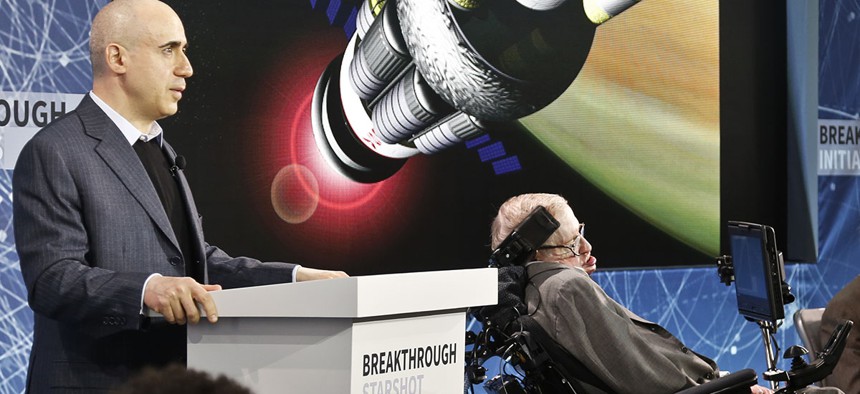The Ambitious Plan to Send a Spacecraft in Search of Life to Nearest Habitable Planet Beyond Our Solar System

Internet investor and science philanthropist Yuri Milner, left, and renowned cosmologist Stephen Hawking, right, discuss the new Breakthrough Initiative focusing on space exploration and the search for life in the universe. Bebeto Matthews/AP
The first attempt to reach the star will likely be from billionaire Yuri Milner.
Technology doesn’t have to be new to be useful. Indeed, the very first technology to let us explore other continents on Earth will also be the technology to let us explore our nearest star. Sails, which our ancestors used to capture the force of wind to power boats, will now harness the force of light to power spacecrafts.
What’s driving the technology is a goal is to reach Proxima Centauri, the Earth’s closest star, and Proxima b, the Earth-like planet orbiting it which was discovered last year. This will be the first attempt to reach the star, which is only 4.3 light years from our sun, and closely examine the planet, which lies in the habitable zone—i.e. where water can exist in a liquid state and thus potentially host life.
The first attempt to reach the star will likely be from billionaire Yuri Milner. In 2016, the Russian entrepreneur, investor and physicist launched the $100-million “Breakthrough Starshot” project, which plans to send tiny spacecrafts, called “nanocrafts,” to Proxima Centauri and its neighboring star Alpha Centauri.
Milner’s Starshot project is part of a series of Breakthrough Initiatives to search for extraterrestrial intelligence. Beyond sending probes to the nearest Earth-like planet beyond our solar system, he is also funding “Breakthrough Listen” to search for radio signals from ET further afield and “Breakthrough Message” to study of the ethics of sending messages to aliens if they exist.
Starshot’s nanocrafts will have light sails, some 172 sq. feet (or 16 sq. meters) in area, and will be powered by an array of lasers from Earth. Calculations suggest in the emptiness of space, with no resistance, the tiny momentum of light particles is enough to slowly accelerate a small spacecraft to nearly a fifth of the speed of light.
There’s just one problem. If these nanocrafts reach such speeds, we still don’t have a way of slowing them down. So when they reach Proxima Centauri, some 20 years after launch from Earth, they will cross the star system in mere hours. In such a short period, they may be able to send back some valuable data about the star system and its planets, but nobody knows if it will be enough to help us create, say, a human mission to the star system.
A more reliable method would be to put the spacecrafts in orbit around the star or its planet. In a new study, researchers at the Max Planck Institute for Solar System Research have a plan to achieve that. Their researchers’ calculations suggest that, with sufficient modifications to a nanocraft, the probe could harness light and gravity from Proxima Centauri and Alpha Centauri to slow down and then fall in orbit around one of the stars.
The needed modifications aren’t simple. First, the sails on these spacecrafts will have to be as large as 1.1 million sq. feet (100,000 sq. meters), about 14 football fields and nearly 10,000 times larger than Starshot’s nanocrafts. The sheer size would demand special materials equally light and tough; graphene might be suitable, according to the researchers, but it isn’t yet clear. Second, to achieve the slow down, the spacecrafts can only be accelerated to about 5 percent of the speed of light. This would increase the time needed to reach Proxima Centauri. It will take about 100 years for the spacecraft to reach its top speed and then another 50 to slow down before being caught in an orbit.
There will be advantages though. To achieve merely 5 percent of speed of light, these nanocrafts won’t need Earth-based lasers and can depend simply on our sun’s light. And once in orbit around the nearest star, they can send us a wealth of information, just as probes around Mars and Saturn are already doing.
The new plans for a nanocraft could complement Milner’s dreams. “Our new mission concept could yield a high scientific return, but only the grandchildren of our grandchildren would receive it,” René Heller, the lead author of the study, said. “Starshot, on the other hand, works on a timescale of decades and could be realized in one generation. So we might have identified a long-term, follow-up concept for Starshot.”





